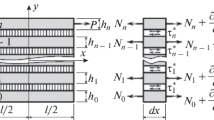Abstract
The temperature and time functions of combination of film materials, one of which is in the glass state and the other in the glass transition state, have shown that the kinetics of the formation of the actual contact surface depend on microrheological processes. Theoretical functions for stress disrupting the adhesion bond have been proposed, and have been checked experimentally by using electron microscope and rheological methods.
Similar content being viewed by others
Literature cited
S. S. Voyutskii, V. E. Gul', Chzhan In'-si, and V. L. Vakula, VMS,4, 285 (1962).
V. E. Gul' and L. L. Kudryashova, Adhesion of Polymers [in Russian], Moscow (1963), p. 134.
V. E. Gul' and L. L. Fomina, VMS,7, 45 (1965).
V. E. Gul', Dokl. Akad. Nauk SSSR,96, 953 (1954).
Additional information
Moscow Technological Institute of the Meat and Milk Industry. Translated from Mekhanika Polimerov, No. 2, pp. 203–208, March–April, 1970.
Rights and permissions
About this article
Cite this article
Gul', V.E., Genel, S.V. & Fomina, L.L. Effect of microrheological processes on the adhesion of a combination of film materials. Polymer Mechanics 6, 184–189 (1970). https://doi.org/10.1007/BF00859187
Received:
Issue Date:
DOI: https://doi.org/10.1007/BF00859187




